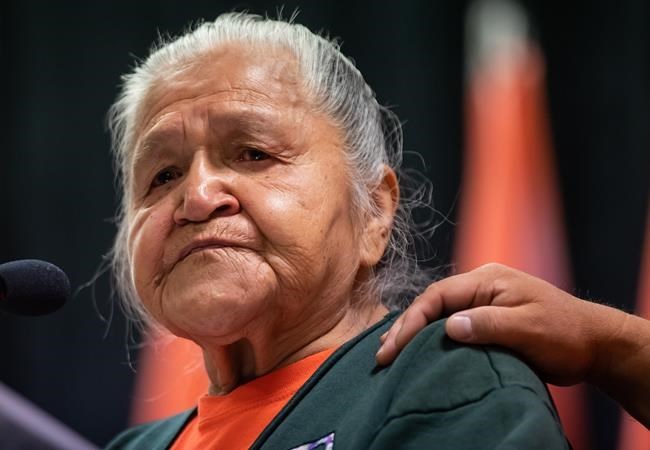KAMLOOPS, B.C. — It took many years for Evelyn Camille to heal from abuse and reclaim her Indigenous identity after spending a decade at a residential school in Kamloops, B.C., where she was taught to be ashamed, the survivor says.
"I don't want to call them schools, because I didn't learn anything there," Camille told a crowd that gathered Thursday to hear about the ongoing investigation into the unmarked graves of children found in May around the site of the former institution.
"When I took the college entrance program, I had Grade 4 level. All we did was cook and clean and, you know, we starved," she said. "We had to steal much of our food in order to survive, and that's only part of our survival in residential schools."
Camille spoke of her experiences as the Tk’emlúps te Secwépemc Nation released more details about the detection of what are believed to be the remains of 215 children using ground-penetrating radar technology.
The expert conducting the search said it began in the apple orchard after a child's rib bone and a tooth were found, and because elders and knowledge keepers have recalled children as young as six being woken in the night to help dig graves there.
"Remote sensing, such as (ground-penetrating radar), is not necessary to know that children went missing in the Indian residential school context," Prof. Sarah Beaulieu of the University of the Fraser Valley told the news conference. "This fact has been recognized by Indigenous communities for generations."
The final report of the Truth and Reconciliation Commission identified up to 6,000 missing children, but anticipated the actual number is greater, Beaulieu noted.
Remote sensing "merely provides some spatial specificity to this truth," she said.
Other Indigenous nations in Canada, including the Cowessess First Nation in Saskatchewan, have also reported finding graves using the same technology.
The search in Kamloops has so far covered less than a hectare of the 65-hectare property, said Beaulieu, a specialist with experience examining Indigenous and city cemeteries and searching for the graves of prisoners during the First World War.
Beaulieu showed radar images and outlined the "signatures" of 200 probable burials. Definitive results would come from forensic examination, she said.Some survivors, including Camille, have expressed desire to leave the site undisturbed.
The Tk'emlúps te Secwépemc Nation would consult with its membership at every step of the investigation moving forward, Chief Rosanne Casimir said.
Casimir thanked survivors of the residential school system, saying they have been "unrelenting in carrying those painful truths about missing children forward."
The repercussions of residential schools are still being felt today, she said.
"We are not here for retaliation," Casimir said. "We are mapping a way forward to bring peace to those missing children, their families and their communities."
She said there has been many years of silence and disbelief about children who never came home from residential schools.
"As I begin to delve further into the harsh reality regarding the missing children, I first wish to remind everyone this is heavy truth," she said.
Casimir called on Prime Minister Justin Trudeau, the federal government and the Catholic Missionary Oblates of Mary Immaculate to release the complete student attendance records for the Kamloops institution so the nation can fulfil its responsibility to identify and reunite the lost children with their home communities.
"Those primary documents, currently within the custody of the Canadian government, will be of critical importance to identify those lost children," she said, adding children were taken to the institution from across B.C., Alberta and Yukon.
The newly elected national chief of the Assembly of First Nations, RoseAnne Archibald, said ground-penetrating radar is revealing indisputable proof that crimes were committed in Canada's residential school system and must be investigated.
"These are crime scenes and so we need some kind of independent investigation."
Archibald said she is working urgently on the issue of unmarked burial sites, and she has made a reasonable request to Prime Minister Justin Trudeau for more funding to support communities searching for lost children at former institutions.
Ottawa has pledged further support for the identification and investigation of burial grounds near former residential schools after allocating $27 million in 2019.
"We recognize that it's just a beginning," Trudeau told a news conference Thursday, and more funding would be provided to communities as necessary.
"We will continue to recommit to sharing any and all records that the federal government has on helping identify these graves," he added.
Survivor Mona Jules said she was six years old and couldn't speak English when she arrived at the Kamloops school.
"The whole school sounded like a beehive," she said. "I couldn't understand anything."
Jules said she spent her life learning and teaching the Secwepemc language.
"I spent years trying to revive what that school has snuffed out," she said. "And it's working."
B.C. Premier John Horgan and Indigenous Relations and Reconciliation Minister Murray Rankin issued a joint statement Thursday, saying the provincial government is committed to working with the Tk'emlúps te Secwépemc and other nations in support of the "vital work" at all residential school sites.
"We have allocated $12 million in new funding for the research at former residential school sites and for the mental health and cultural supports for communities that are critical for healing," the statement said.
The Indian Residential Schools Resolution Health Support Program has a hotline to help residential school survivors and their relatives suffering with trauma invoked by the recall of past abuse. The number is 1-866-925-4419.
This report by The Canadian Press was first published July 15, 2021.
The Canadian Press



